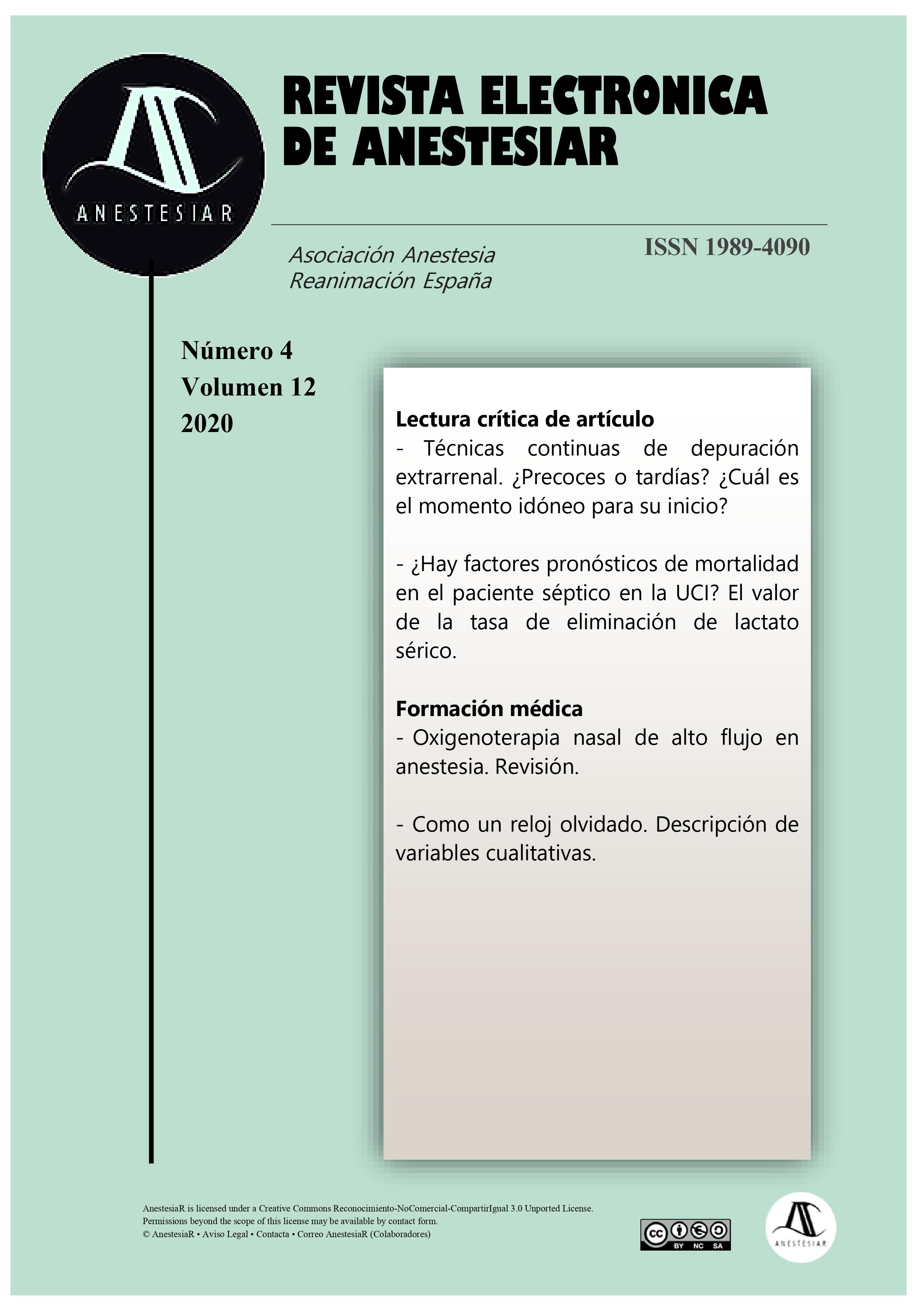High-flow nasal oxygen therapy in anesthesia. A review
DOI:
https://doi.org/10.30445/rear.v12i4.800Keywords:
High flow nasal oxygen therapy, THRIVE technique, HFNC, POINT, THRIVE, HFNOAbstract
High-flow nasal oxygen therapy is a relatively new tool that has aorused much expectation in different health-care settings, being used in patients with different underlying conditions.
Its physiological advantages, which make it unique and the finding of new uses, with possible indications in anesthesia that could imply important implications, especially in the management of the airway, have led to a growing interest also in the field of anesthesiology.
We have reviewed articles published between 2015 and November 2018, after doing a search in Pubmed, especially oriented on the role of this new technique in the perioperative period.
Besides explaining what the technique consists of, we comment on physiological benefits (some with greater scientific evidence), indications especially in anesthesia (assessing the current scientific support), contraindications, adverse effects, conclusions and current trends. Finally, we finish by presenting a series of questions that need to be resolved and that require further study.
References
- Badiger S, John M, Fearnley RA, Ahmad I. Optimizing oxygenation and intubation conditions during awake fibre-optic intubation using a high-flow nasal oxygen delivery system. Br J Anaesth 2015;115:629-32
- Nishimura M. High-flow nasal cannula oxygen therapy in adults: physiological benefits, indication, clinical benefits, and adverse effects. Respir Care 2016;61:529-541
- Groves N, Tobin A. High flow nasal oxygen generates positive airway pressure in healthy volunteers. Aust Crit Care 2007;20:126-131
- Cortegiani A, Accurso G, Mercadante S, Giarratano A, Gregoretti C. High Flow nasal therapy in perioperative medicina: from operating room to general ward. BMC Anesthesiol 2018;18:166
- Miguel-Montanes R, Hajage D, Messika J, Et al. Use of high Flow nasal cannula oxygen therapy to prevent desaturation during thacheal intubation of intensive care patients with mild-to-moderate hypoxemia. Crit Care Med 2015;43:574-83
- Mc Narry AF, Patel A. The evolution of airway management- new concepts and conflicts with traditional practice. Br J Anaesth 2017;119:154-66
- Patel A, Nouraei SAR. Transnasal Humidified rapid-insufflation ventilatory exchange (THRIVE): A physiological method of increasing apnoea time in patients with difficult airway. Anaesthesia 2015;70:323-9
- Doyle AJ, Stolady D, Mariyaselvam M, Wijewardena G, Gent E, Blunt M, Young P. Preoxygenation and apneic oxygenation using transnasal humidified rapid-insufflation ventilatory exchange for emergency intubation. J Crit Care 2016;36:8-12
- Gustafsson I-M, Lodenius A, Tunelli J, Ullman J, Fagerlund MJ. Apneic oxygenation in adults under general anesthesia using transnasal humidified rapid-insufflation ventilatory exchange (THRIVE)- a physiological study. Br J Anaesth 2017;118:610-7
- Mir F, Patel A, Iqbal R, Cecconi M and Nouraie SAR. A randomized controlled trial comparing transnasal humidified rapid insufflation ventilatory exchange (THRIVE) preoxygenation with facemask pre-oxygenation in patient undergoing rapid sequence induction of anaesthesia. Anaesthesia 2017;72:439-443
- Chan Lee CH, Perez O, Farooqi FI, Akella T, Shaharyar S, Elizee M. Use of high-flow nasal cannula in obese patients receiving colonoscopy under intravenous propofol sedation: A case series. Resp Med Care Reports 2018;23;118-121
- MS, FM, AFMN. THRIVE? The answer, my friend, is blowing in the (high flow) wind¡ Trend Anaesth Crit Care 2018;22:63-65
- Rajan S, Joseph N, Tosh P, Kadapamannil D, Paul J, Kumar L. Effectiveness of transnasal humidified rapid-insufflation ventilatory exchange versus traditional preoxygenation followed by apneic oxygenation in delaying desaturation during apnoea: a preliminary study. Indian J. Anaesth 2018;62:202-207
- Hengen M, Willemain R, Meyer A, Langer B, Joshi GP, Diemunsch P. Transnasal humidified rapid-insufflation ventilatory exchange for preoxygenation before cesarean delivery under general anesthesia: a case report. A&A case reports 2017;9:216-8
- Shallik N, Zaghw A, Hammad Y. Is the time to update the ASA difficult airway algorithm? Trend Anaesth Crit Care 2018;22:61-62
- Shallik N, Karmakar A. It is time for high flow nasal oxygen to se included in the difficult airway algorithm? Br J Anaesth 2018;121:511-512
Downloads
Published
How to Cite
Issue
Section
License
Copyright (c) 2020 Revista Electrónica AnestesiaR

This work is licensed under a Creative Commons Attribution-ShareAlike 4.0 International License.
 Envío y derechos de autor
Envío y derechos de autor


 Revista Electrónica AnestesiaR by
Revista Electrónica AnestesiaR by 